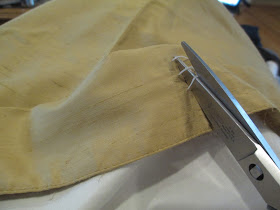I've already blogged about my mock-up. Now it was time to cut out the real thing! I started with the bodice lining, as the pattern instructed. I had overlocked, washed and pressed the cotton lining of one of the curtains to use for the bodice lining. I made my adjustments to the back piece according to the fit of my mock-up. I angled the center back edge 1 1/4" away from the fold at the bottom, up to nothing at the top:
I put the lining together just as I had made the mock-up, with the addition of the front facings. I tried it on over my stays:
 |
| The stays are not yet finished - I still need to add the binding. |
Brian the Engineer tied the laces in back to bring in the excess fabric at center back:
Now I could finally cut my silk! Which is always a nerve-wracking endeavor. So far, the most time-consuming part has been prepping the fabric.
The first thing I needed to do was remove the curtain hardware from my fabric. I actually did this months ago. The curtains were gathered at the top in bunches, with metal hooks for hanging on the curtain rod. I took out the gathering stitches first.
The hooks were held in place by plastic threads:
They slid out quite easily:
Then I had to remove whatever these things are:
I'm sure there's a name for them, but I don't know what it is.
Then I needed to un-pick all of the edges and press out all of the creases from the hems. I used my handy little spray bottle of vinegar to help release the creases and diminish the stitch marks:
I noticed that two of the six curtains were just the full width of the original fabric, selvedge to selvedge, but the other four had the selvedge only along one side and the other side trimmed away.
Not sure why that is, but I set aside the two full-width ones to use for the petticoat. This way I won't have to finish the seam allowances on the inside of the petticoat. That will save some time.
I also found that some of the curtains had a different selvedge edge than the others:
Anyway, all the unpicking and pressing took forever. But finally I could cut out the gown!
 |
| I noticed a bit of fading on one of the panels, but it's not terribly noticeable. |
I had to cut the pieces on my dining room table, as my cutting table in my sewing room is not large enough to accommodate most of the major pattern pieces.
 |
| In fact, the dining room table was barely large enough! |
From one panel I got the two front pieces, the sleeves, and the sleeve flounces. From another I cut the side skirt extensions, the back neck piece, and the stomacher. I cut two stomacher pieces rather than just one, as I imagine I'll make at least two for mix-and-match. Two more panels got me the back pieces, and the bottom portions of all panels will be cut into strips for trim!
Just for fun, I laid out all of the pieces on the table after they were cut. They wouldn't all fit without overlapping!
And I couldn't get the whole table in the photo frame, even standing on a chair.
At which point Jazz decided to join me, because clearly I needed "help."
 |
| Helper cat is helping. |
Ok, time to get stitching!























This is going to look amazing! Thanks for the vinegar tip, I didn't realize that it helped to remove creases.
ReplyDeleteOh yes, vinegar is wonderful for pressing hard creases. It's also good if you're trying to put creases INTO fabric!
Delete